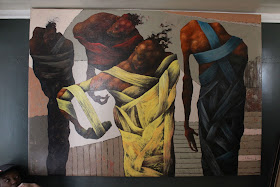By
Margaretta wa Gacheru (posted 31 July 2018)
Four
exceptional exhibitions of Kenyan art just opened this past week in Nairobi,
illustrating once again that contemporary Kenyan art is thriving. It’s also
surprising since all four are group shows (two at one venue) displaying recent works
that haven’t been shown in public before.
The most socially
relevant of the four is at Circle Art Gallery featuring ‘Recent’ works by three
artists based at the Wajukuu Art Project. All three, Lawrence ‘Shabu’ Mwangi,
Joseph ‘Weche’ Waweru and Ngugi ‘Googs’ Waweru are founder members of Wajukuu,
which is a community-based cultural centre set deep in Mukuru slum. All three critically
appraise various aspects of urban life in their art. Weche is sensitive to the
congestion of city life and the struggles that hardworking Kenyans face just to
survive. Creating seemingly abstract patterns in his work, his message gains
clarity if one appreciates the way his creatures (ants apparently) serve to
symbolize human experience.
Googs, on
the other hand, had first-hand experience with gun violence when his
grandmother got shot. She survived but that hasn’t stopped him exploring the
issue of gun violence in his art. And Shabu’s paintings often reflects on the
plight of the oppressed and disadvantaged. Their show will run through August 21th.
In sharp
contrast to Wajukuu’s gritty but graceful approach is the exhibition at Polka
Dot Gallery entitled ‘Why I love Kenya’. Filled with idyllic images of the most
exquisite natural features of Kenyan landscapes, one will find images of some
of the most beautiful spots in the country by painters like Patrick Kinuthia,
Yony Waite, Coster Ojwang, Nayianoi Sitonik, Anne Mwiti, David Roberts, Caroline
Mbirua and Leah Njenga.
At the same
time, the show reflects aspects of urban life by artists like Wycliffe ‘Wiki’
Opondo, Kennedy Kinyua, Nelson Ijakaa, Damba Ismael and Wilson Matunda. In all,
it’s a lovely showcase of the country’s beauty. Most of it’s in paintings, both
oils and acrylics, but a few, like Wiki’s images of Kibera, are etchings.
Finally, it
was at One Off Gallery that one saw the opening of not one but two very
different exhibitions. Ever since Carol Lees transformed her stable into
gallery space, she’s brought a diversity of works together. In this case, the
art in the ex-stable was curated by Thom Ogonga and Jonathan Solanye. Meanwhile,
she assembled the recent artworks by some of her favorite artists, including
Anthony Okello, Olivia Prendergast, James Mbuthia, Harrison Mburu, Collin Sekajugo,
Naomi van Rampelberg inside the original gallery, The Loft.
But the
newest works that stole the show last Saturday afternoon were in the Stable,
where Thom had invited several artists to submit works to an exhibition he’d
entitled ‘Line: the Basic Element’.
Those who
responded included everyone from Mercy Kagia, David Thuku, Florence Wangui,
Wanjohi Maina, Longinos Nagila and Sebawali Sio to Ndeithi Kariuki, Janice
Ichi, Patti Endo, Agnes Waruguru and co-curator Jonathan Solanke.
The
simplicity of the artists’ works contributed to the wonder of this show. Some
worked in silkscreen (like David Thuku and Wanjohi Maina), others in acrylics
(like Janice Iche), others ink and watercolor (Mercy Kagia and Patti Endo) and
still others in charcoal and pastels (like Florence Wangui and Jonathan
Solanke). Longinos Nagila and Agnes Waruguru both worked in mixed media. But
possibly the most surprising works using this basic element of a simple line,
were aluminum wire sculptures by Ndeithi Kariuki. A marketing manager by day,
he does his art at night and on weekends. One can see how music has inspired
his art since one’s a silhouette of Jimi Hendrix’s guitar, the other two hands
on piano keys playing jazz.













































